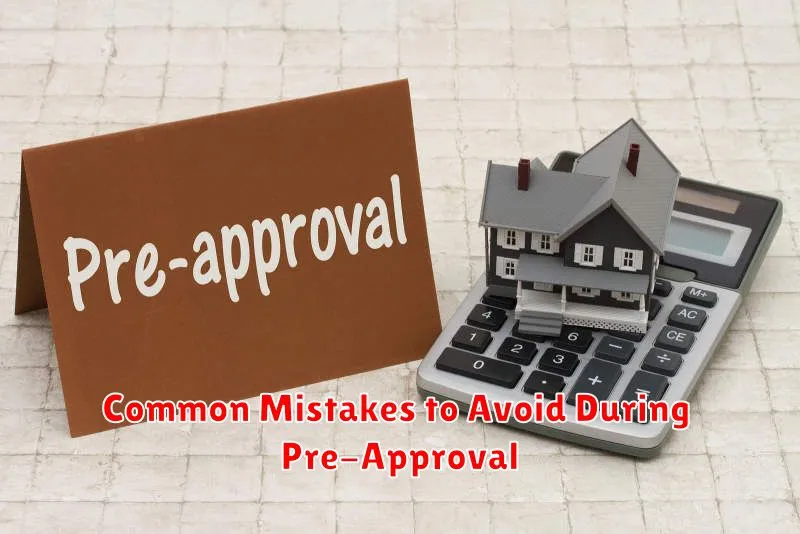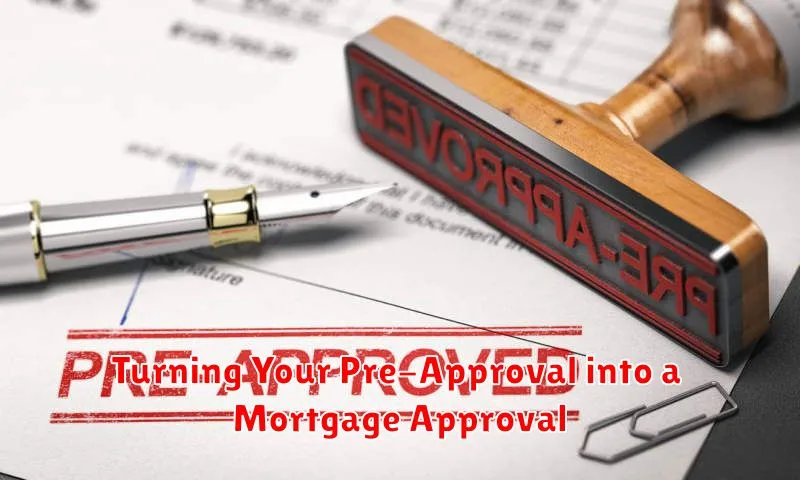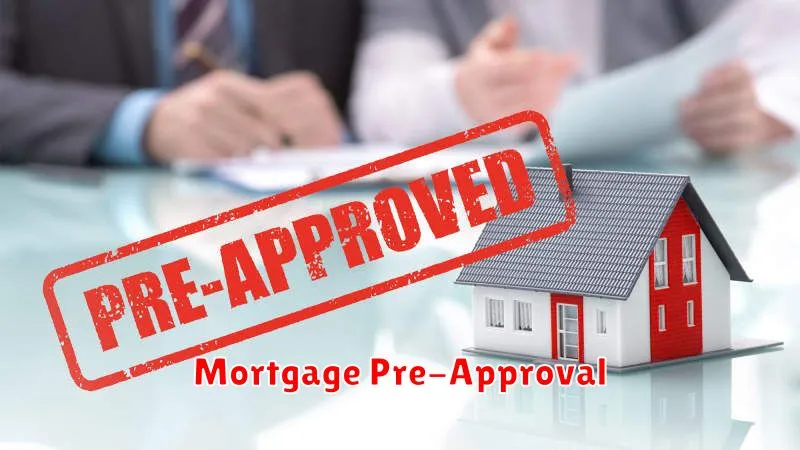Are you ready to take the plunge into homeownership? The journey to owning your dream home can be exciting, but it’s also important to be prepared. One crucial step in the process is obtaining a mortgage pre-approval. This crucial step allows you to know exactly how much you can borrow, giving you a clear picture of your budget and making you a more competitive buyer in the market. A pre-approval letter from a lender is a powerful tool, showcasing your financial readiness to sellers and providing them with the confidence to accept your offer.
Navigating the mortgage pre-approval process might seem daunting, but it doesn’t have to be. This guide will walk you through the steps involved, from gathering necessary documents to understanding your credit score and loan options. We’ll break down the process into simple, digestible steps, equipping you with the knowledge and confidence to secure a pre-approval that sets you up for success in your home-buying journey.
What is Mortgage Pre-Approval?
Mortgage pre-approval is a critical step in the home buying process. It’s an informal assessment from a lender that tells you how much money you’re likely to borrow based on your credit score, income, and debt-to-income ratio. In essence, it’s a preliminary approval for a mortgage, giving you an idea of the amount you can afford to spend on a house.
Pre-approval isn’t a guarantee of a loan, but it demonstrates to sellers that you’re a serious buyer with the financial capacity to purchase their property. This can make your offer more competitive and can even lead to faster closing times.
Benefits of Mortgage Pre-Approval
- Helps you determine a realistic budget
- Strengthens your offer to sellers
- Saves time during the closing process
- Provides an understanding of your interest rates and loan terms
While not mandatory, mortgage pre-approval is highly recommended. It empowers you with knowledge about your financial capabilities and presents you as a credible buyer in the competitive real estate market.
Benefits of Getting Pre-Approved
Getting pre-approved for a mortgage is a crucial step in the home-buying process. It offers numerous advantages, making it a wise choice for any prospective buyer.
Firstly, pre-approval demonstrates your financial readiness to the seller, showcasing your serious intent to purchase. This can give you a competitive edge, especially in a seller’s market.
Secondly, pre-approval provides a clear picture of your buying power, enabling you to focus your search on homes within your budget. This prevents disappointment from falling in love with properties you cannot afford.
Thirdly, pre-approval strengthens your negotiating position. Armed with a pre-approval letter, you can confidently make offers without the uncertainty of financing approval.
Finally, pre-approval streamlines the closing process. Once you find your dream home, a pre-approval allows for a smooth and efficient transaction, often resulting in a faster closing time.
In conclusion, obtaining pre-approval offers significant benefits for prospective homebuyers. It strengthens your position, provides clarity, and ultimately leads to a more successful and stress-free home-buying experience.
Understanding Your Credit Score and History
Your credit score is a numerical representation of your creditworthiness, reflecting your ability to manage debt responsibly. It’s a critical factor lenders use to assess your risk when you apply for a mortgage. A higher credit score indicates a lower risk to lenders, potentially leading to better interest rates and loan terms.
Your credit history is the detailed record of your borrowing and repayment activities, encompassing factors like:
- Payment history: On-time payments demonstrate responsible financial behavior.
- Credit utilization: This ratio of credit used to credit available influences your score significantly.
- Credit age: A longer credit history generally translates to a higher score.
- Credit mix: A diverse credit mix (e.g., credit cards, loans) showcases responsible borrowing practices.
- Hard inquiries: Numerous recent inquiries from potential lenders can negatively impact your score.
Before embarking on the pre-approval process, take proactive steps to understand your credit score and history:
- Obtain a free credit report: You’re entitled to a free copy of your credit report from each of the three major credit bureaus (Experian, Equifax, and TransUnion) annually through AnnualCreditReport.com.
- Dispute any errors: Carefully review your reports and dispute any inaccuracies that may be lowering your score.
- Improve your credit score: If your score needs improvement, consider:
- Paying down debt
- Maintaining a low credit utilization ratio
- Paying bills on time
- Avoid unnecessary hard inquiries
A strong understanding of your credit score and history empowers you to navigate the mortgage pre-approval process with confidence. It’s essential to ensure your creditworthiness aligns with your mortgage aspirations.
Documents Required for Pre-Approval
Before you start shopping for a home, it’s crucial to get pre-approved for a mortgage. This process involves providing your lender with essential documents that showcase your financial health and ability to repay the loan. This pre-approval gives you a clear understanding of your borrowing power, helping you set a realistic budget for your home search.
Here’s a list of documents you’ll typically need for mortgage pre-approval:
- Personal Identification: Driver’s license, passport, or other government-issued ID.
- Social Security Number: Needed to verify your identity and credit history.
- Proof of Income: Recent pay stubs, W-2 forms, tax returns, and/or bank statements for self-employed individuals.
- Assets: Bank statements for savings, checking, retirement accounts, and investment accounts.
- Debt Information: Recent statements for credit cards, student loans, auto loans, and other outstanding debts.
- Employment Information: Current employment letter or pay stubs, and previous employment information if applicable.
It’s important to gather all required documents before starting the pre-approval process. Having them readily available will streamline the process and avoid delays. Make sure the documents are current and accurate to ensure a smooth pre-approval experience. If you have any questions or uncertainties, feel free to reach out to your lender for clarification.
Finding a Reputable Lender or Mortgage Broker
Once you’ve gotten pre-approved, you’ll need to find a lender or mortgage broker. A lender is a financial institution, such as a bank or credit union, that provides mortgage loans directly. A mortgage broker acts as an intermediary, helping you find the best mortgage loan from a variety of lenders.
When choosing a lender or broker, you’ll want to make sure they’re reputable and offer competitive rates and terms. Here are a few tips for finding a reputable lender or mortgage broker:
- Ask for referrals from friends, family, or real estate agents.
- Check online reviews and ratings.
- Make sure they’re licensed and insured.
- Compare rates and fees from several lenders or brokers.
It’s also important to ask about the lender’s or broker’s experience, track record, and customer service.
Once you’ve chosen a lender or broker, you’ll need to provide them with some personal and financial information, such as your income, credit score, and assets. They’ll use this information to determine your eligibility for a mortgage loan and to provide you with a personalized rate quote.
Submitting Your Pre-Approval Application
Once you’ve selected a lender and gathered all the necessary documents, it’s time to submit your pre-approval application. Most lenders have online portals where you can complete the application electronically, which is often the fastest and most convenient option. However, you can also submit your application via phone, email, or in person.
As part of the application, you’ll likely be asked to provide your:
- Personal information, such as your name, address, Social Security number, and date of birth
- Employment history, including your current employer, income, and length of employment
- Financial information, such as your credit score, debt-to-income ratio, and assets
- Information about the property you plan to purchase, such as the address, purchase price, and type of property
Once you’ve submitted your application, the lender will review it and make a decision. This process typically takes a few business days. If your application is approved, you’ll receive a pre-approval letter that outlines the terms of your loan, including the loan amount, interest rate, and monthly payments.
It’s important to note that a pre-approval letter is not a guarantee of a loan. The lender will still need to review your application and the property in detail before issuing a final loan approval. However, a pre-approval letter gives you a strong indication of how much you can borrow, which can be helpful in making an offer on a home.
How Long Does the Pre-Approval Process Take?
The pre-approval process can take anywhere from a few days to a few weeks, depending on several factors, including the lender’s efficiency, the complexity of your financial situation, and how quickly you provide the required documentation.
Here’s a breakdown of the typical timeline:
- Initial application and document submission: This can take a few hours to a day.
- Lender review and verification: This can take a few days to a week.
- Credit report and background check: This typically takes a few business days.
- Final pre-approval decision: This can take a few days to a week, depending on the complexity of your application.
To expedite the process, ensure you have all the necessary documents ready and respond promptly to any requests from the lender. This includes:
- Proof of income (pay stubs, tax returns)
- Bank statements
- Credit report
- Debt-to-income ratio (DTI)
What to Expect After Pre-Approval
Once you’ve secured a pre-approval, you’re one step closer to homeownership. It’s now time to start shopping for a home! You can now confidently search for a property knowing that you’ve been approved for a loan up to a certain amount. However, it’s crucial to remember that pre-approval isn’t a guarantee of a loan.
After pre-approval, you’ll be entering the home search phase. You’ll work with a real estate agent to find properties that match your needs and budget. During this time, you may be required to provide updated financial information, such as recent pay stubs and bank statements, to ensure your pre-approval is still valid.
Once you’ve found your dream home, your lender will need to conduct a formal loan application. This process involves reviewing your financials in more detail and verifying your income, assets, and credit history. The lender will also need to assess the property you’re purchasing, which involves an appraisal to determine its market value.
If everything checks out, you’ll receive a loan commitment, which signifies the lender’s approval to fund your mortgage. Keep in mind, even though you’ve been pre-approved, it’s possible that your loan application could be declined during the formal process. This could be due to changes in your financial circumstances, issues with the property itself, or even unforeseen problems with your credit history.
Factors That Can Affect Your Pre-Approval
Getting pre-approved for a mortgage is an important step in the home-buying process. It gives you a clear idea of how much you can borrow and allows you to make a more confident offer on a home. However, several factors can affect your pre-approval amount. Understanding these factors can help you improve your chances of getting the best possible pre-approval.
Credit Score
Your credit score is one of the most important factors influencing your pre-approval. A higher credit score generally translates to better loan terms, including lower interest rates. This means you can borrow more money with a lower monthly payment. If you have a lower credit score, you may need to improve it before applying for a mortgage. This can be done by paying bills on time, reducing credit card debt, and avoiding new credit applications.
Debt-to-Income Ratio (DTI)
Your debt-to-income ratio (DTI) is another crucial factor that lenders consider. Your DTI is calculated by dividing your monthly debt payments by your gross monthly income. A lower DTI usually indicates a lower risk for lenders, which can lead to a higher pre-approval amount. You can lower your DTI by paying down existing debt or increasing your income.
Employment History
Lenders want to ensure you have a stable income, and your employment history plays a significant role in determining your pre-approval. They typically look at your job stability and length of employment. A consistent work history and a stable job can positively affect your pre-approval amount.
Down Payment
The size of your down payment can also impact your pre-approval amount. A larger down payment can reduce the loan amount you need to borrow, which may result in more favorable loan terms. It’s important to note that some lenders may require a specific minimum down payment, which can vary depending on the loan type and your specific circumstances.
Property Type
The type of property you intend to buy can influence your pre-approval amount. Certain property types, such as investment properties or commercial properties, may require different loan terms or higher down payments than traditional single-family homes.
By understanding the factors that can affect your pre-approval amount, you can take steps to improve your chances of getting the best possible pre-approval. Be sure to shop around and compare offers from different lenders to find the best terms available. Remember to keep your credit score healthy, manage your debt wisely, and demonstrate financial stability to increase your chances of getting a favorable pre-approval.
Common Mistakes to Avoid During Pre-Approval

While pre-approval is a relatively simple process, it’s important to avoid common mistakes that could delay or even jeopardize your loan application.
Here are some crucial tips to ensure a smooth pre-approval experience:
- Don’t Apply for New Credit. Opening new accounts can impact your credit score, potentially jeopardizing your pre-approval or causing a higher interest rate.
- Avoid Large Purchases. Major purchases like vehicles, appliances, or even furniture can affect your debt-to-income ratio, leading to a lower loan amount or denial.
- Don’t Switch Jobs. A recent job change can raise concerns about your financial stability. It’s best to remain in your current position until after you secure the loan.
- Keep Your Bank Accounts Steady. Unusual activity or low balances in your accounts can raise red flags during the verification process. Avoid making significant changes to your accounts before and during pre-approval.
- Be Transparent About Your Finances. Providing accurate and complete financial information is crucial. Don’t try to hide any debts or income discrepancies, as this can lead to delays and complications.
By avoiding these common pitfalls, you can ensure a streamlined pre-approval process and position yourself for a smooth home buying experience.
Tips for a Smooth and Successful Process
The pre-approval process is a crucial step in the home buying journey, setting the stage for a smooth and successful experience. To make this process as seamless as possible, consider these essential tips:
1. Gather Your Financial Documents: Before applying for pre-approval, compile all necessary financial documents, including pay stubs, bank statements, tax returns, and credit card statements. Having this information readily available will streamline the application process.
2. Be Honest and Transparent: Providing accurate and complete information is critical. This ensures a realistic pre-approval amount and avoids delays or complications later on. Be upfront about any debts, credit issues, or other factors that may affect your eligibility.
3. Shop Around: Compare offers from multiple lenders to find the best rates and terms that align with your financial goals. Don’t hesitate to negotiate for a lower interest rate or better terms if possible.
4. Understand the Pre-Approval Commitment: A pre-approval commitment is not a guarantee of a loan. It’s an indication of how much you’re likely to be approved for based on your current financial situation. It’s essential to maintain your creditworthiness and financial stability throughout the process.
5. Communicate Clearly with Your Lender: Stay in touch with your lender throughout the process, keeping them informed of any changes in your financial circumstances or employment status. Open communication helps maintain a smooth flow and ensures that you’re on the right track.
Turning Your Pre-Approval into a Mortgage Approval

After securing a pre-approval, the next step in your home-buying journey is getting a full mortgage approval. This transition requires a deeper dive into your financial history and involves additional documentation. While pre-approval provides a good estimate, the final approval determines your actual loan amount and terms. To successfully transition from pre-approval to approval, follow these steps:
1. Choose a lender: If you haven’t already, select a lender based on factors like interest rates, loan programs, and customer service. 2. Complete a full application: Be prepared to provide comprehensive financial information, including tax returns, pay stubs, and bank statements. 3. Credit and income verification: The lender will thoroughly review your credit score and income to assess your loanworthiness. 4. Property appraisal: An independent appraiser will evaluate the property’s market value to ensure it aligns with the loan amount. 5. Final loan approval: Once all documentation is reviewed and approved, you will receive your final mortgage approval, outlining the loan amount, interest rate, and other terms.
Turning a pre-approval into a full mortgage approval is a crucial step. By meticulously following these steps and maintaining clear communication with your lender, you can smoothly transition from pre-approval to a final mortgage approval, paving the way for your dream home purchase.

